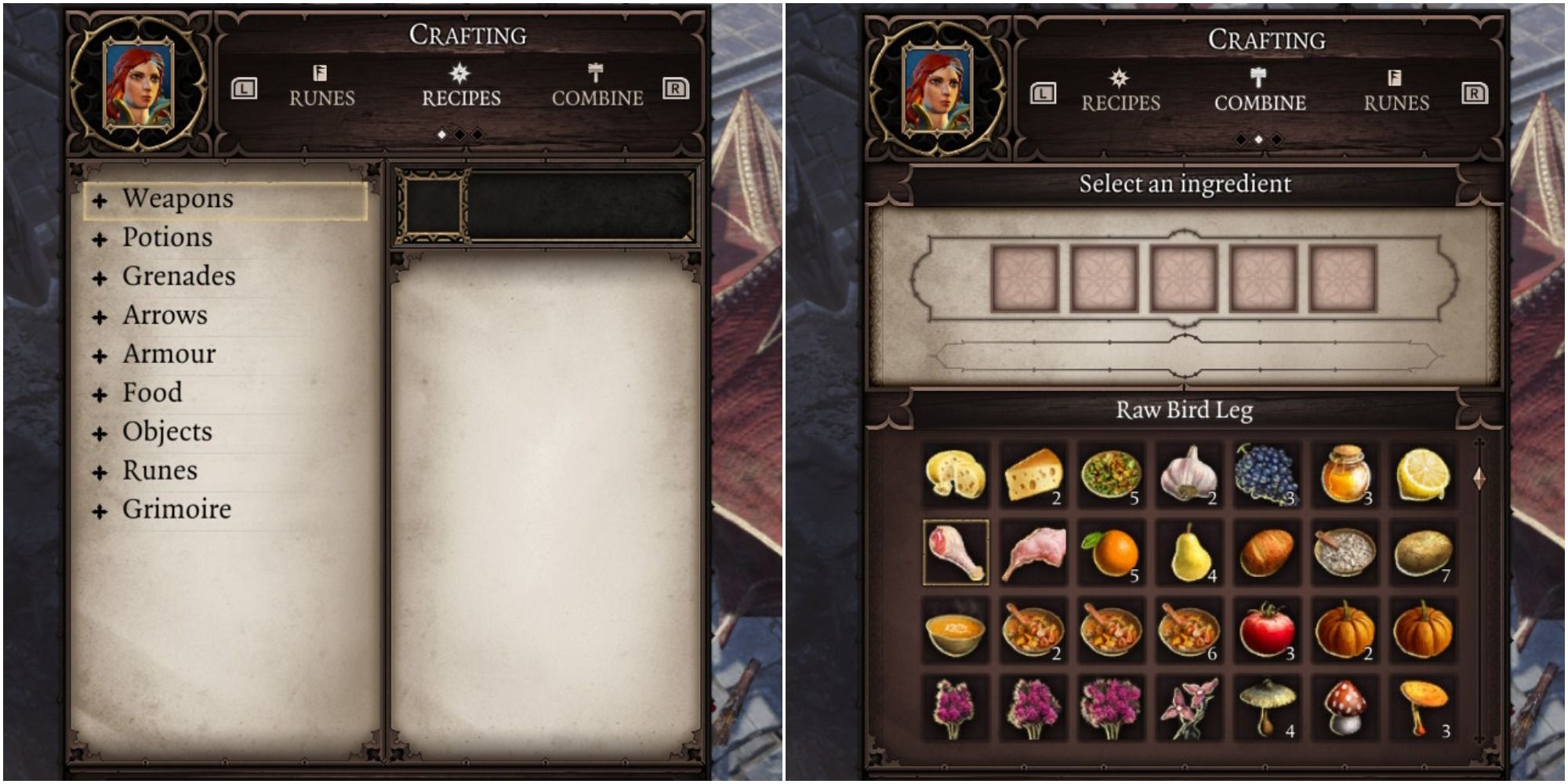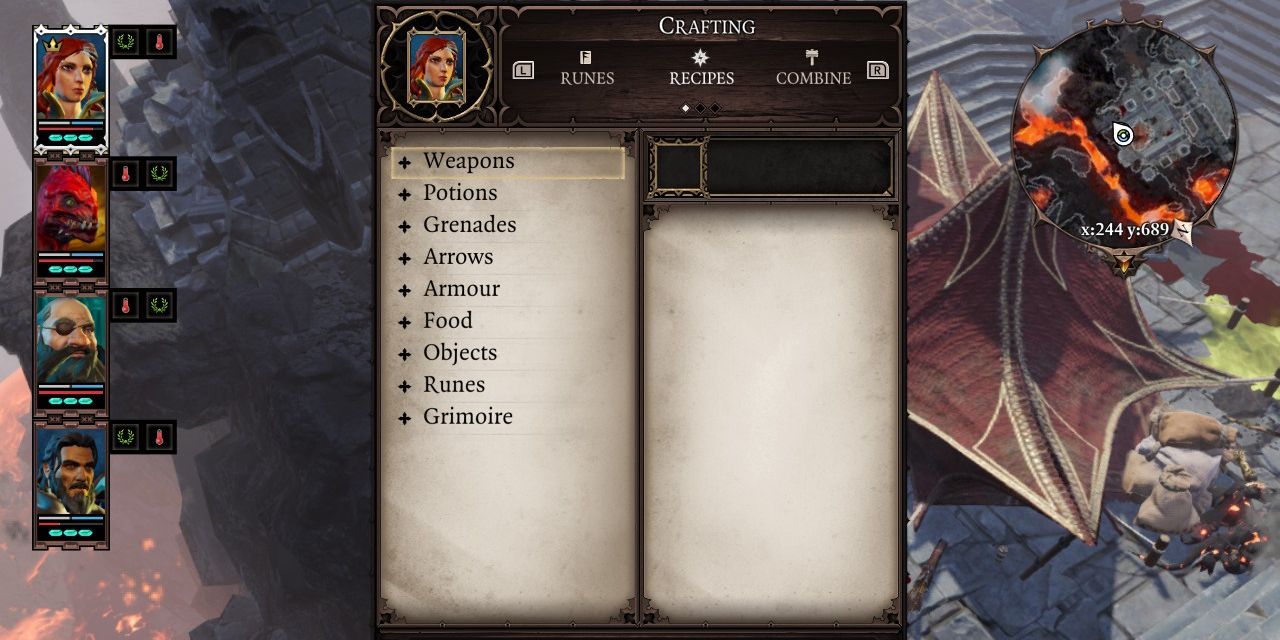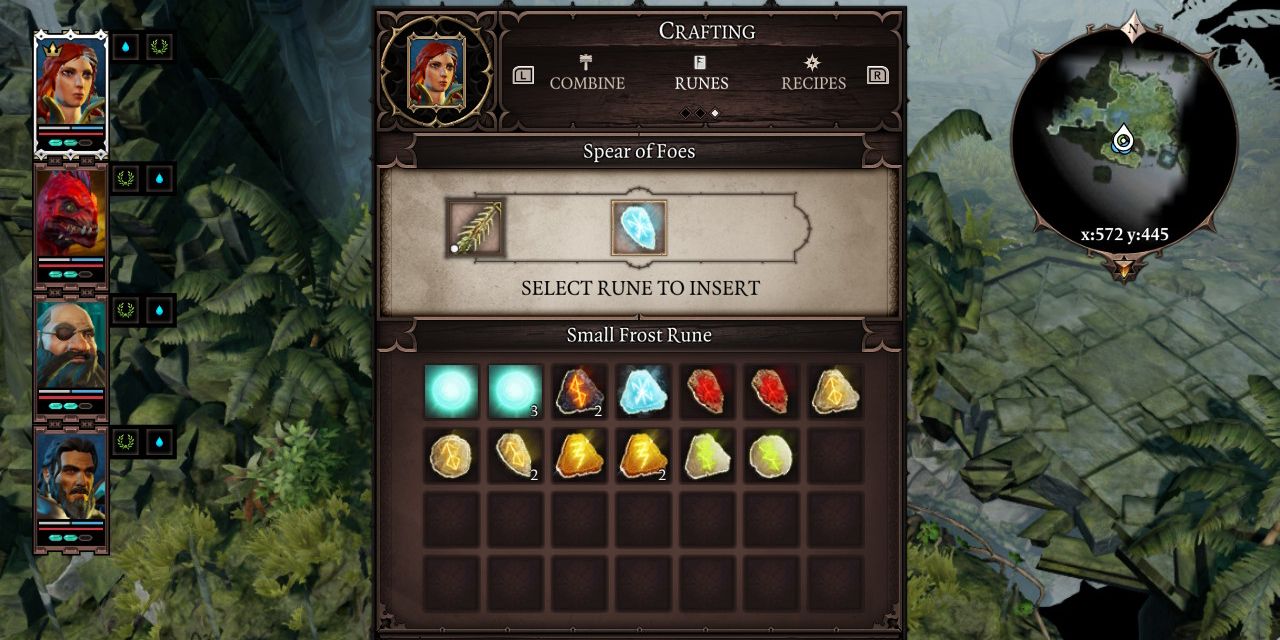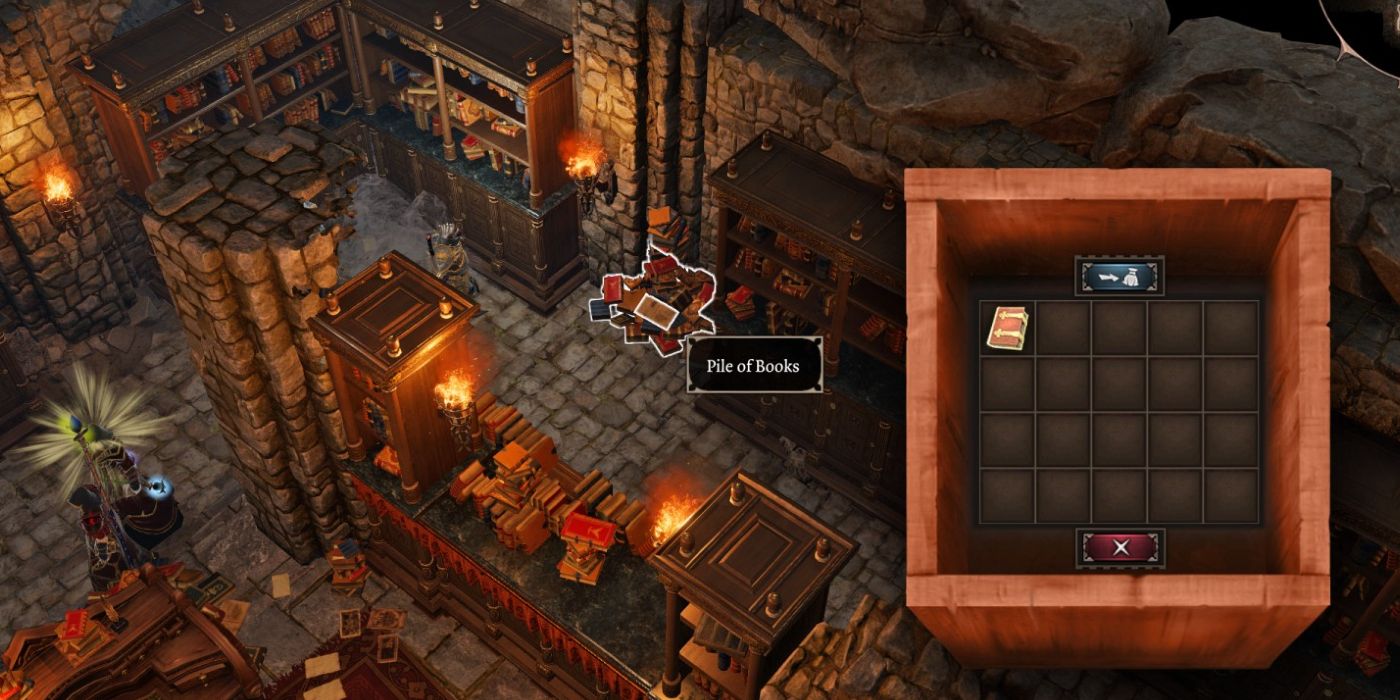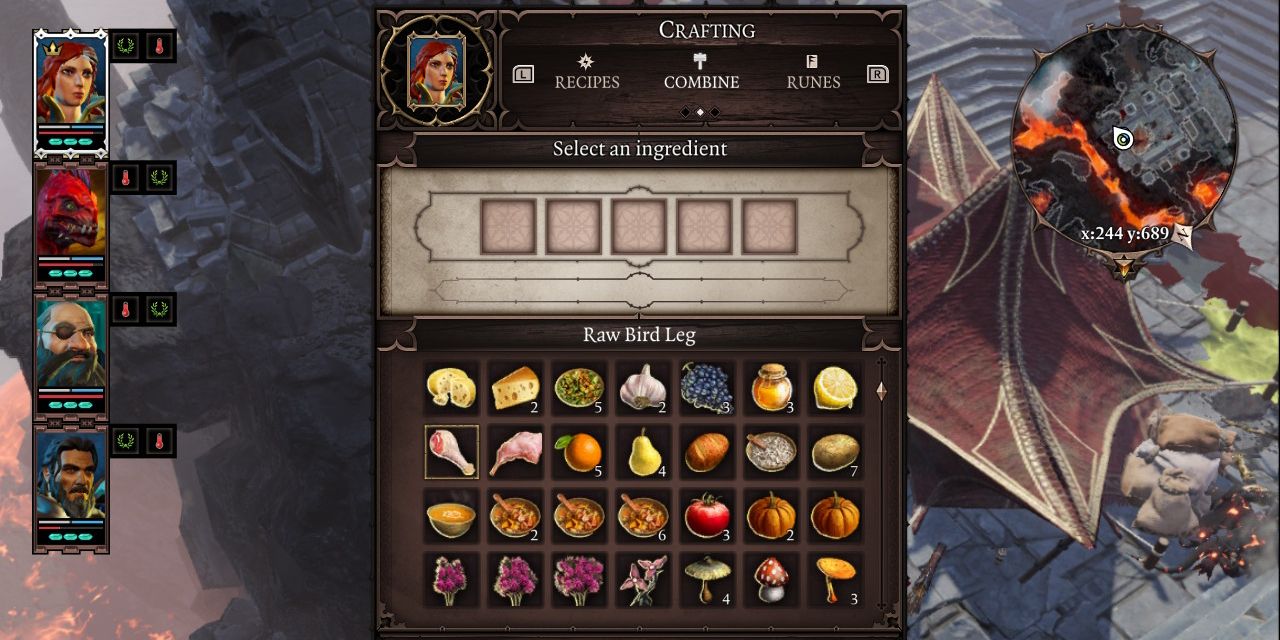Crafting is a cornerstone of the RPG genre, and Divinity: Original Sin 2 is no different. As the Godwoken and their companions venture through Rivellon, they'll come across a wide variety of items they can use to craft handy tools — even if they're not sure how at first.
Though the game's crafting system isn't the most intuitive, utilizing it grants the player helpful items and saves a lot of gold. Different play styles will make use of different aspects, but every player can find some way to put their skills to use in this game mechanic. Here's how to navigate it.
What Players Can Craft
There's a huge array of craftable items in Original Sin 2. In the Recipe section of the crafting menu, these are broken down into categories: weapons, potions, grenades, arrows, armor, food, objects, runes, and grimoire.
Weapons
This crafting category comes in handy until around level three. When they first arrive in Fort Joy, players are fairly defenseless; these recipes allow them to craft such magnificent weapons as Makeshift Wand and Sharp Stone On A Stick. This crafting category quickly becomes obsolete once players start picking up decent gear.
Potions
On the other hand, this category comes in handy over the course of the whole game. Healing items are essential for a ragtag group of Godwoken being hunted by Magisters and Voidwoken alike. Players should grab empty potion bottles wherever they can, and use Rivellon's flora to make elixirs to heal and buff themselves. Adding augmentors to crafted potions can make them more potent.
Grenades
Perfect in a pinch, use these to wreak havoc when spells are on cooldown. Every player is bound to pick some up in their travels, but crafting even more will come in handy often. Use grenade canisters, and pack them with things that go boom.
Arrows
This is a more situational category, but it's essential if there's a Ranger or Wayfarer in the party (and there always should be). Combine plain arrowheads with a variety of items to create elementally damaging projectiles, and combine those with arrow shafts to make usable arrows.
Armor
Like weapons, this category is only useful early on. Players can scrap together some shirts and pants and boots, but they will quickly find much better gear from enemies and shops.
Food
While they may not provide buffs as impressive as potions, it's still absolutely worth the player's time to pick up culinary ingredients and cook when they can. Potion ingredients aren't too common, but food can be found almost anywhere.
Many recipes require a cooking station. Players can use any stoves they come across in the world, or use campfires if they have a cooking pot.
Objects
A vague term for a vague category, this section covers bits and bobs such as lockpicks, backpacks, cooking stations, and a few quest-specific items.
Runes
These are essential items for enchanting weapons and gear. Players can use these to help boost their lackluster crafted weapons and armor early on, giving them a bit more power. Each rune's effect depends on its element and what item the player applies it to.
Grimoire
This category encompasses skill books and scrolls. A skill book will permanently teach a character a skill, while a scroll provides a single, immediate use. Most players will craft scrolls more frequently, as sheets of paper are easy to come by. These are always useful in desperate battle situations, so when preparing for a tough fight, don't forget to consult the Grimoire.
Understanding The Enchanting Menu
Enchanting is a subset of the crafting system in Original Sin 2, and a bit more complex than simply putting ingredients together until something happens. Here, players can use runes to imbue their gear with new effects, or amplify existing ones. Each type of rune has set effects depending on whether it is applied to a weapon, armor, or an amulet/ring. The effects increase in potency based on the rune's size.
Standard Runes
- Fire: Adds Fire Damage to the weapon; provides Fire Resistance on armor; increases Critical Chance on jewelry.
- Frost: Adds Water Damage to the weapon; provides Water Resistance on armor; increases Movement on jewelry.
- Masterwork: Adds additional Physical Damage to the weapon; provides additional Physical Resistance on armor; increases maximum Magic Armor on jewelry.
- Rock: Adds Earth Damage to the weapon; provides Earth Resistance on armor; increases maximum Vitality on jewelry.
- Thunder: Adds Air Damage to the weapon; provides Air Resistance on armor; increases Dodging on jewelry.
- Venom: Adds Poison Damage to the weapon; provides Poison Resistance on armor; increases Accuracy on jewelry.
Runes Of Power
Runes bearing the addendum "of Power" will add an additional effect along with the standard one when used to enchant gear. These do not vary with gear type.
- Fire: Increases Intelligence
- Frost: Increases Intelligence
- Masterwork: Increases Strength
- Rock: Increases Strength
- Thunder: Increases Finesse
- Venom: Increases Finesse
Mystical Runes
As with Runes of Power, the following each provides another benefit in addition to the standard one. These, however, do vary by gear type.
- Fire: Increases Ranged on a weapon; increases Huntsman on armor; increases Pyrokinetic on jewelry.
- Frost: Increases Single-Handed on a weapon; increases Leadership on armor; increases Hydrosophist on jewelry.
- Masterwork: Increases Wits on a weapon; increases Constitution on armor; increases Memory on jewelry.
- Rock: Increases Two-Handed on a weapon; increases Warfare on armor; increases Geomancer on jewelry.
- Thunder: Increases Dual Wielding on a weapon; increases Scoundrel on armor; increases Aerotheurge on jewelry.
- Venom: Increases Perseverence on a weapon; increases Summoning on armor; increases Necromancer on jewelry.
How To Learn Recipes
There are a couple different ways for players to expand their crafting repertoire in Divinity: Original Sin 2. Once learned, recipes can be accessed from a tab in the crafting menu. Selecting one of these will allow the player to immediately craft as many of that item as they have ingredients for. Here's how to find recipes.
Read Books
In a game with as much lore as the Divinity series, it's always wise for players to skim through every book they find. However, these tomes can have an additional benefit: several within the game will teach players useful crafting recipes.
In particular, look for installments of the "Rhymes of the Scribes" or "Crafting Bible" series; these typically have several recipes in store. Others can hold handy tips too, though, so don't pass any volumes over.
Experiment Freely
Unlike other games such as Skyrim, components used in failed crafting experiments will not be consumed in Original Sin 2. For example, if the player mixes a sheet of paper and an arrowhead — a combination that creates absolutely nothing — those two items will remain in the inventory.
With that in mind, players shouldn't let ingredient supplies stop them from trying new creations. Combine arrowheads with every available material until a new type reveals itself. Put every kind of mushroom and herb into an empty bottle. Of course, it may get tedious after several failed attempts, but at least the only thing the player wastes will be time.

